Part 2 of 2
On the deepest psychological level the film’s plot symbolizes the search for God, and it finally postulates what is little less than a scientific definition of God.
—Stanley Kubrick (to Rolling Stone magazine, on 2001)
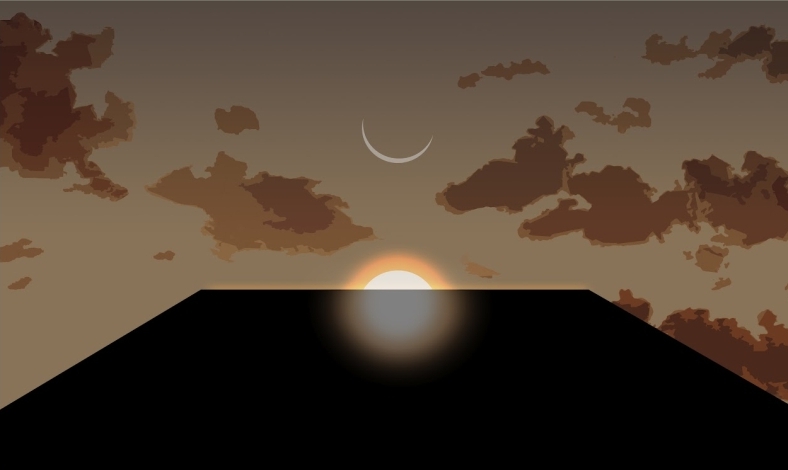
The Esoteric Aspect
The Pilgrimage signifies the return to the Origin—not only the origin of Islam, of monotheism and of humanity, but the Source of all that is, namely, God.
We may start our investigation with the Sufis, who are loosely known as the mystics of Islam. Every true religion consists of exoteric teaching, i.e. external rules and procedures, and esoteric teaching which reveals inner meaning. The literalist or exoterist is concerned only with the outward, the esoterist only with the inward. The Sufis are followers of the Middle Way, upholding both the inner and the outer. In this sense, then, “Sufism = true Islam.”
According to the Sufis, the Kaaba on earth is a symbol for the Heart in man. We capitalize the word “heart” in order to distinguish it from the blood pump made of flesh; the Heart the Sufis mean is not your physical ticker, but its spiritual counterpart. The heart is located at the center of the human body, just as the Kaaba is located at the center of the world (more about this below). Just as the Kaaba was cleared of idols when Mecca was conquered, all idols, associates, and anything other than God should be cleansed from the Heart if we wish to conquer Paradise. According to Fritjof Schuon: “The pilgrimage is a pre-figuration of the inward journey toward the kaaba of the heart...” [15] The famous mystic poet Rumi notes in his Discourses that the Kaaba stands for union with God. We have already seen that the elevated, purified Heart of the Perfect Man corresponds to the House of Splendor, the Heavenly archetype and counterpart of the Kaaba. “Build a Heart,” say the Sufis, “and you build the Kaaba; ruin (break) a Heart, and you wreck the Kaaba.”
Why have the Sufis accorded such great importance to the Heart? And why have they compared it to the Kaaba? Because the Heart is the dwelling-place, the seat, of God. “The heavens and the earth cannot contain Me,” says God in a Holy Tradition, “but the Heart of my Faithful servant does.” Hence, when God declares: “Purify My House” (22:26), the exoterist understands this to mean the physical building of the Kaaba. The Sufi does not deny this, but claims that it has a further meaning, namely, “Purify your Heart,” so that the divine light may shine through.
This light has often been compared to the light of the sun, the sphere of which, as we have seen, has the same symbolic significance as the Cube (Kaaba). According to the famous Sufi sage and author of The Perfect Man, Abdulkarim Jili, the sun is analogous to the heart (qalb).
 Gold, as we know, is the solar metal, and according to another great Sufi sage, Ibn Arabi, gold is the symbol of the original purity of the soul. Each child is born with that purity, [16] and it can be regained by great effort. Since equivalent symbols can be substituted for each other, we can exchange the sun with gold to obtain “a heart of gold,” or vice versa to obtain a “soul of light” or “enlightened soul.”
Gold, as we know, is the solar metal, and according to another great Sufi sage, Ibn Arabi, gold is the symbol of the original purity of the soul. Each child is born with that purity, [16] and it can be regained by great effort. Since equivalent symbols can be substituted for each other, we can exchange the sun with gold to obtain “a heart of gold,” or vice versa to obtain a “soul of light” or “enlightened soul.”
The number 7 occurs in the seven counterclockwise (viewed from above) circuits, the seven trips between the Twin Hills, and the seven stones thrown at the three pillars (symbolizing the three appearances of the devil to Hagar, Abraham, and Ishmael). [17] This is the number of levels of selfhood in Sufism: 1. the Base Self, 2. the Critical Self, 3. the Inspired Self, 4. The Serene (Contented) Self, 5. the Pleased (with God) Self, 6. the (God-)Pleasing Self, and 7. the Purified (Perfected) Self. In other words, one circumambulation, trip, or pebble corresponds to each stage in the development of the self. [18]
The Arabic word tafa, from which tawaf (circumambulation) is derived, can mean “to attain the summit of a thing by spiraling around it.” [19] The circumambulation, according to Jili, “signifies that we must attain to our selfhood, origin, root, point of union.” [20]
Now the sense of an ascent by spiraling immediately suggests a vertical dimension. But since one does not climb to the top of the Kaaba during circumambulation, but remains circling at ground level, this vertical elevation must involve, not the third dimension of height, but another dimension. We shall shortly return to this subject. For now, let us move on to consider the meaning of the sacrifice.
According to Ibn Arabi writing in the Meccan Revelations (Futuhat), as with Shakespeare and Schopenhauer later on, “life is but a dream.” This is supported by the Saying of the Prophet: “Men are asleep; when they die they wake up.” In that case, says Arabi, the events occurring in one’s life can, and should, be interpreted exactly as one interprets symbols in a dream. He has written elsewhere (Fusus, “the Bezels of Wisdom”) that Abraham should have interpreted his sacrifice dream symbolically, in which case he would have seen the truth, that he would be sacrificing a ram rather than his own son.
All this goes to show that the sacrifice of the ram in real life is itself a symbolic act. Sacrifice has been a part of religion all over the world, and has signified people’s adoration of their Lord (or in polytheism, which is a degeneration of monotheism, of more than one deity). Its meaning, however, lies deeper.
“Sacrifice,” sacrum plus facere, means “to make sacred.” In Arabic as in Hebrew, korban means “closeness” (to God). Of course, this cannot mean that the sacrificial animal is somehow being sacralized or becoming closer to God. Rather, the offerer of the sacrifice is himself attaining sacrality, is by this act becoming close to God. And finally, it is the sacrifice of himself to God that is involved. What is meant by this is not that one should commit suicide—for otherwise the Faithful would cease to exist, which is obviously not what God intends—but that one should purify one’s self of all things displeasing to the Lord. One should sacrifice the things that are most pleasing to one’s self in order to draw closer to God. In Abraham’s case this was his son, whom he loved most. But since this is a tall order—how many of us ordinary mortals are prepared to sacrifice the things we love?—God has accepted, from us, the sacrifice of a substitute in their stead. This has been specified and institutionalized in order to avoid confusion.
The sacrifice, then, is symbolic of our sacrifice of our selves, or of those things associated with the self which prevent us from attaining closeness to God.
As for the Zamzam water: water symbolizes life, purity, and nourishment. By drinking the Zamzam, one purifies oneself, both materially and spiritually.
Being bathed in sunlight while standing still at Arafat is symbolic of the pilgrim’s being “washed” and “clothed” in divine light. According to a saying of the Prophet: “The (Major) Pilgrimage is Arafat,” while according to another of his sayings, Abraham set the precedent in this case as well.
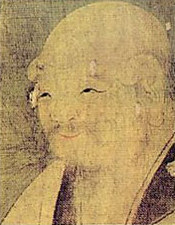 Finally, let us consider the meaning of shaving the head. In Christianity as well as in other religions, the tonsure has been a distinction of priests and the pious. Hairlessness is characteristic of both old age, signifying wisdom, and of extreme infancy, signifying the innocence and purity of a newborn baby (the author of the Tao Te Ching was called Lao Tzu, widely claimed to mean “old boy”). In a very real sense, the Pilgrim has died to his old self and been reborn: has donned a “shroud” during the Restriction, has gone through what is even now an ordeal, and come out intact—and, hopefully, transformed—on the other side. Further, a shining head is a solar symbol representing spiritual enlightenment, depicted by the halos of saints. Hence, the shaving of the head denotes the completion of the Pilgrimage, and signifies that one has been rewarded by the Lord for one’s troubles—has been promoted to an exalted station. Like Clarke’s monoliths, the Kaaba is a “door of transcendence”: it uplifts the spirit of the pilgrim in the same way that they transform ape-men into man or man into Star-Child.
Finally, let us consider the meaning of shaving the head. In Christianity as well as in other religions, the tonsure has been a distinction of priests and the pious. Hairlessness is characteristic of both old age, signifying wisdom, and of extreme infancy, signifying the innocence and purity of a newborn baby (the author of the Tao Te Ching was called Lao Tzu, widely claimed to mean “old boy”). In a very real sense, the Pilgrim has died to his old self and been reborn: has donned a “shroud” during the Restriction, has gone through what is even now an ordeal, and come out intact—and, hopefully, transformed—on the other side. Further, a shining head is a solar symbol representing spiritual enlightenment, depicted by the halos of saints. Hence, the shaving of the head denotes the completion of the Pilgrimage, and signifies that one has been rewarded by the Lord for one’s troubles—has been promoted to an exalted station. Like Clarke’s monoliths, the Kaaba is a “door of transcendence”: it uplifts the spirit of the pilgrim in the same way that they transform ape-men into man or man into Star-Child.
We may start our investigation with the Sufis, who are loosely known as the mystics of Islam. Every true religion consists of exoteric teaching, i.e. external rules and procedures, and esoteric teaching which reveals inner meaning. The literalist or exoterist is concerned only with the outward, the esoterist only with the inward. The Sufis are followers of the Middle Way, upholding both the inner and the outer. In this sense, then, “Sufism = true Islam.”
According to the Sufis, the Kaaba on earth is a symbol for the Heart in man. We capitalize the word “heart” in order to distinguish it from the blood pump made of flesh; the Heart the Sufis mean is not your physical ticker, but its spiritual counterpart. The heart is located at the center of the human body, just as the Kaaba is located at the center of the world (more about this below). Just as the Kaaba was cleared of idols when Mecca was conquered, all idols, associates, and anything other than God should be cleansed from the Heart if we wish to conquer Paradise. According to Fritjof Schuon: “The pilgrimage is a pre-figuration of the inward journey toward the kaaba of the heart...” [15] The famous mystic poet Rumi notes in his Discourses that the Kaaba stands for union with God. We have already seen that the elevated, purified Heart of the Perfect Man corresponds to the House of Splendor, the Heavenly archetype and counterpart of the Kaaba. “Build a Heart,” say the Sufis, “and you build the Kaaba; ruin (break) a Heart, and you wreck the Kaaba.”
Why have the Sufis accorded such great importance to the Heart? And why have they compared it to the Kaaba? Because the Heart is the dwelling-place, the seat, of God. “The heavens and the earth cannot contain Me,” says God in a Holy Tradition, “but the Heart of my Faithful servant does.” Hence, when God declares: “Purify My House” (22:26), the exoterist understands this to mean the physical building of the Kaaba. The Sufi does not deny this, but claims that it has a further meaning, namely, “Purify your Heart,” so that the divine light may shine through.
This light has often been compared to the light of the sun, the sphere of which, as we have seen, has the same symbolic significance as the Cube (Kaaba). According to the famous Sufi sage and author of The Perfect Man, Abdulkarim Jili, the sun is analogous to the heart (qalb).

 Gold, as we know, is the solar metal, and according to another great Sufi sage, Ibn Arabi, gold is the symbol of the original purity of the soul. Each child is born with that purity, [16] and it can be regained by great effort. Since equivalent symbols can be substituted for each other, we can exchange the sun with gold to obtain “a heart of gold,” or vice versa to obtain a “soul of light” or “enlightened soul.”
Gold, as we know, is the solar metal, and according to another great Sufi sage, Ibn Arabi, gold is the symbol of the original purity of the soul. Each child is born with that purity, [16] and it can be regained by great effort. Since equivalent symbols can be substituted for each other, we can exchange the sun with gold to obtain “a heart of gold,” or vice versa to obtain a “soul of light” or “enlightened soul.” The number 7 occurs in the seven counterclockwise (viewed from above) circuits, the seven trips between the Twin Hills, and the seven stones thrown at the three pillars (symbolizing the three appearances of the devil to Hagar, Abraham, and Ishmael). [17] This is the number of levels of selfhood in Sufism: 1. the Base Self, 2. the Critical Self, 3. the Inspired Self, 4. The Serene (Contented) Self, 5. the Pleased (with God) Self, 6. the (God-)Pleasing Self, and 7. the Purified (Perfected) Self. In other words, one circumambulation, trip, or pebble corresponds to each stage in the development of the self. [18]
The Arabic word tafa, from which tawaf (circumambulation) is derived, can mean “to attain the summit of a thing by spiraling around it.” [19] The circumambulation, according to Jili, “signifies that we must attain to our selfhood, origin, root, point of union.” [20]
Now the sense of an ascent by spiraling immediately suggests a vertical dimension. But since one does not climb to the top of the Kaaba during circumambulation, but remains circling at ground level, this vertical elevation must involve, not the third dimension of height, but another dimension. We shall shortly return to this subject. For now, let us move on to consider the meaning of the sacrifice.
According to Ibn Arabi writing in the Meccan Revelations (Futuhat), as with Shakespeare and Schopenhauer later on, “life is but a dream.” This is supported by the Saying of the Prophet: “Men are asleep; when they die they wake up.” In that case, says Arabi, the events occurring in one’s life can, and should, be interpreted exactly as one interprets symbols in a dream. He has written elsewhere (Fusus, “the Bezels of Wisdom”) that Abraham should have interpreted his sacrifice dream symbolically, in which case he would have seen the truth, that he would be sacrificing a ram rather than his own son.
All this goes to show that the sacrifice of the ram in real life is itself a symbolic act. Sacrifice has been a part of religion all over the world, and has signified people’s adoration of their Lord (or in polytheism, which is a degeneration of monotheism, of more than one deity). Its meaning, however, lies deeper.
“Sacrifice,” sacrum plus facere, means “to make sacred.” In Arabic as in Hebrew, korban means “closeness” (to God). Of course, this cannot mean that the sacrificial animal is somehow being sacralized or becoming closer to God. Rather, the offerer of the sacrifice is himself attaining sacrality, is by this act becoming close to God. And finally, it is the sacrifice of himself to God that is involved. What is meant by this is not that one should commit suicide—for otherwise the Faithful would cease to exist, which is obviously not what God intends—but that one should purify one’s self of all things displeasing to the Lord. One should sacrifice the things that are most pleasing to one’s self in order to draw closer to God. In Abraham’s case this was his son, whom he loved most. But since this is a tall order—how many of us ordinary mortals are prepared to sacrifice the things we love?—God has accepted, from us, the sacrifice of a substitute in their stead. This has been specified and institutionalized in order to avoid confusion.
The sacrifice, then, is symbolic of our sacrifice of our selves, or of those things associated with the self which prevent us from attaining closeness to God.
As for the Zamzam water: water symbolizes life, purity, and nourishment. By drinking the Zamzam, one purifies oneself, both materially and spiritually.
Being bathed in sunlight while standing still at Arafat is symbolic of the pilgrim’s being “washed” and “clothed” in divine light. According to a saying of the Prophet: “The (Major) Pilgrimage is Arafat,” while according to another of his sayings, Abraham set the precedent in this case as well.
 Finally, let us consider the meaning of shaving the head. In Christianity as well as in other religions, the tonsure has been a distinction of priests and the pious. Hairlessness is characteristic of both old age, signifying wisdom, and of extreme infancy, signifying the innocence and purity of a newborn baby (the author of the Tao Te Ching was called Lao Tzu, widely claimed to mean “old boy”). In a very real sense, the Pilgrim has died to his old self and been reborn: has donned a “shroud” during the Restriction, has gone through what is even now an ordeal, and come out intact—and, hopefully, transformed—on the other side. Further, a shining head is a solar symbol representing spiritual enlightenment, depicted by the halos of saints. Hence, the shaving of the head denotes the completion of the Pilgrimage, and signifies that one has been rewarded by the Lord for one’s troubles—has been promoted to an exalted station. Like Clarke’s monoliths, the Kaaba is a “door of transcendence”: it uplifts the spirit of the pilgrim in the same way that they transform ape-men into man or man into Star-Child.
Finally, let us consider the meaning of shaving the head. In Christianity as well as in other religions, the tonsure has been a distinction of priests and the pious. Hairlessness is characteristic of both old age, signifying wisdom, and of extreme infancy, signifying the innocence and purity of a newborn baby (the author of the Tao Te Ching was called Lao Tzu, widely claimed to mean “old boy”). In a very real sense, the Pilgrim has died to his old self and been reborn: has donned a “shroud” during the Restriction, has gone through what is even now an ordeal, and come out intact—and, hopefully, transformed—on the other side. Further, a shining head is a solar symbol representing spiritual enlightenment, depicted by the halos of saints. Hence, the shaving of the head denotes the completion of the Pilgrimage, and signifies that one has been rewarded by the Lord for one’s troubles—has been promoted to an exalted station. Like Clarke’s monoliths, the Kaaba is a “door of transcendence”: it uplifts the spirit of the pilgrim in the same way that they transform ape-men into man or man into Star-Child.
Signs and Similitudes
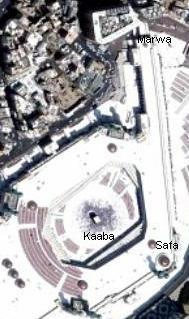 Each age must perforce understand religion according to its own conceptions. This does not mean that the basics of religion can be changed, but rather that our mentality is different from that of our ancestors, as indeed our children’s will be from ours. This means that the same truths will be retold in every age in an idiom specific to that age. Is there anything in our age that would help us better understand the details of the Pilgrimage?
Each age must perforce understand religion according to its own conceptions. This does not mean that the basics of religion can be changed, but rather that our mentality is different from that of our ancestors, as indeed our children’s will be from ours. This means that the same truths will be retold in every age in an idiom specific to that age. Is there anything in our age that would help us better understand the details of the Pilgrimage?
The Koran constantly exhorts human beings to investigate the phenomena that surround us. This emphasis led to Islamic interest in all fields of knowledge, which, as science historian George Sarton (of Harvard) and others have reminded us, laid the basis for the Renaissance and modern science. God Himself declares that He has created signs in all things (6:95-9) for human beings. Among such signs are the forces of nature (89:1-5). “We will show them our signs on the horizons and their own souls” (41:53), He says—signs “on earth, in your own selves, and in Heaven” (51:20-3). God also proclaims that He will not hesitate to draw a simile from even a gnat. As Goethe said:
 Each age must perforce understand religion according to its own conceptions. This does not mean that the basics of religion can be changed, but rather that our mentality is different from that of our ancestors, as indeed our children’s will be from ours. This means that the same truths will be retold in every age in an idiom specific to that age. Is there anything in our age that would help us better understand the details of the Pilgrimage?
Each age must perforce understand religion according to its own conceptions. This does not mean that the basics of religion can be changed, but rather that our mentality is different from that of our ancestors, as indeed our children’s will be from ours. This means that the same truths will be retold in every age in an idiom specific to that age. Is there anything in our age that would help us better understand the details of the Pilgrimage? The Koran constantly exhorts human beings to investigate the phenomena that surround us. This emphasis led to Islamic interest in all fields of knowledge, which, as science historian George Sarton (of Harvard) and others have reminded us, laid the basis for the Renaissance and modern science. God Himself declares that He has created signs in all things (6:95-9) for human beings. Among such signs are the forces of nature (89:1-5). “We will show them our signs on the horizons and their own souls” (41:53), He says—signs “on earth, in your own selves, and in Heaven” (51:20-3). God also proclaims that He will not hesitate to draw a simile from even a gnat. As Goethe said:
One aspect of these signs and similitudes is that they also have symbolic significance in the spiritual realm (in our selves). Every object and every process in the universe has a hidden meaning, and science, in the full unfolding of its discoveries, has also—when viewed in a different light—been cataloguing “the knowledge of hidden things” (Ar. ilm ladunni). This is meant not only in the sense that science is discovering previously unknown things about the physical world, though it includes this meaning as well. If we knew, in addition, what these physical truths corresponded to in the spiritual/psychic and symbolic realms, we would then be in possession of “hidden wisdom.” For example, the transformation of carbon into diamond under great heat and pressure represents the transmutation of an ordinary human being, after great ordeals, into the “divine body” of a Perfect Man. What other lessons might be drawn from the discoveries of modern science and technology for our present purposes? 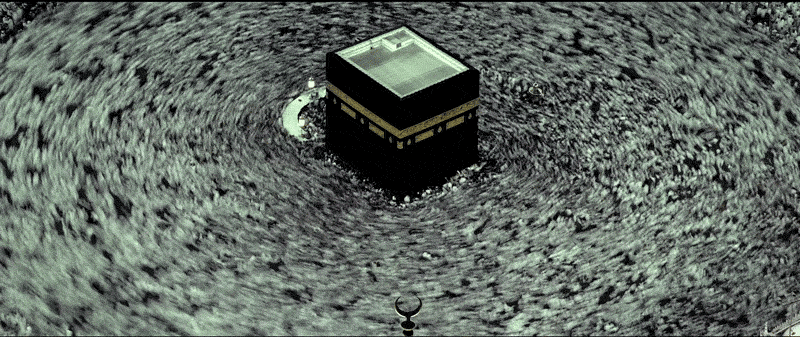

Everything perishable Is but an allegory
—for the Eternal, that is.
Accelerated time-frame picture of the Kaaba showing Pilgrim flow. Note the whirlpool or vortex effect. For the scientifically-minded, the counterclockwise direction of flow is the same as that of low-pressure weather systems in the Northern Hemisphere (due to the Coriolis Effect).
The first analogy that the circumambulation of the Kaaba brings to mind is the circling of the planets around the sun. In physics, an object in orbital motion is understood to be undergoing acceleration, even if its angular velocity does not change, because its direction is continually being altered by a force (in the case of the planets, gravitation). Another interesting correspondence is to be found in the realm of electromagnetism.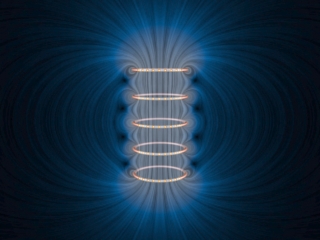 Electrons move in a circular path under the influence of a magnetic field; or, conversely, the circular motion of electrons gives rise to a magnetic field perpendicular to the plane defined by the circle in which the motion takes place. The transverse fields of electric and magnetic force are in fact intimately related, so that it makes more sense to talk about an electromagnetic field rather than to consider the two fields in isolation. The helical motion of electrons in a coil gives rise to a strong magnetic field directed along the axis of the coil.
Electrons move in a circular path under the influence of a magnetic field; or, conversely, the circular motion of electrons gives rise to a magnetic field perpendicular to the plane defined by the circle in which the motion takes place. The transverse fields of electric and magnetic force are in fact intimately related, so that it makes more sense to talk about an electromagnetic field rather than to consider the two fields in isolation. The helical motion of electrons in a coil gives rise to a strong magnetic field directed along the axis of the coil.
This relationship between the electric and magnetic fields made possible the first particle accelerator: the cyclotron, invented by Ernest O. Lawrence. Electrons emitted from a central point were kept under the influence of a constant magnetic field and an alternating electrical field to spiral outward in a plane, accelerating as they did so.
 Electrons move in a circular path under the influence of a magnetic field; or, conversely, the circular motion of electrons gives rise to a magnetic field perpendicular to the plane defined by the circle in which the motion takes place. The transverse fields of electric and magnetic force are in fact intimately related, so that it makes more sense to talk about an electromagnetic field rather than to consider the two fields in isolation. The helical motion of electrons in a coil gives rise to a strong magnetic field directed along the axis of the coil.
Electrons move in a circular path under the influence of a magnetic field; or, conversely, the circular motion of electrons gives rise to a magnetic field perpendicular to the plane defined by the circle in which the motion takes place. The transverse fields of electric and magnetic force are in fact intimately related, so that it makes more sense to talk about an electromagnetic field rather than to consider the two fields in isolation. The helical motion of electrons in a coil gives rise to a strong magnetic field directed along the axis of the coil. This relationship between the electric and magnetic fields made possible the first particle accelerator: the cyclotron, invented by Ernest O. Lawrence. Electrons emitted from a central point were kept under the influence of a constant magnetic field and an alternating electrical field to spiral outward in a plane, accelerating as they did so.
The Accelerator

These early attempts to obtain highly energetic particles have culminated in the giant particle accelerators of our day. Consider, for example, the CERN facility at Geneva, Switzerland. Its Super Proton Synchrotron (SPS) accelerates protons around a circular path up to energies of 24 billion electron volts (GeV). Even more impressive, however, is CERN’s Large Hadron Collider (LHC), a mammoth ring-shaped tunnel with a 27-kilometer circumference, where gigantic superconducting electromagnets whip particles up to within a fraction of the speed of light, and their collisions are monitored by supercomputers to unlock the secrets of the primordial fireball and the Big Bang.
Two points may be singled out for examination from these examples. The first is the relationship between circular (or spiral or helical) motion and acceleration, which means, in the end, an increase in energy. The second is that the circular motion of electric charges is coupled to a magnetic force field in the third dimension.
Now, there is no need to insist on the differences. Nothing could be more obvious than the differences between an elementary particle and a human “particle,” which are enormous and obvious at a glance. Yet one might, perhaps, be forgiven for wondering whether some kind of force field may not in some way be involved in the circumambulation of the Kaaba—not necessarily a physical force field, but a spiritual force field that either creates, or is created by, but is in any case inextricably linked to the ceaseless circular motion of untold millions of human beings. By an application of the principle of equivalence, the descent of God’s Grace may, perhaps, be viewed as a bestowal of, and thus an increase in, spiritual/psychic energy. Furthermore, the circular motion would be linked to a force field in a higher dimension than the plane in which the circular motion occurs—not necessarily the third dimension.
Two points may be singled out for examination from these examples. The first is the relationship between circular (or spiral or helical) motion and acceleration, which means, in the end, an increase in energy. The second is that the circular motion of electric charges is coupled to a magnetic force field in the third dimension.
Now, there is no need to insist on the differences. Nothing could be more obvious than the differences between an elementary particle and a human “particle,” which are enormous and obvious at a glance. Yet one might, perhaps, be forgiven for wondering whether some kind of force field may not in some way be involved in the circumambulation of the Kaaba—not necessarily a physical force field, but a spiritual force field that either creates, or is created by, but is in any case inextricably linked to the ceaseless circular motion of untold millions of human beings. By an application of the principle of equivalence, the descent of God’s Grace may, perhaps, be viewed as a bestowal of, and thus an increase in, spiritual/psychic energy. Furthermore, the circular motion would be linked to a force field in a higher dimension than the plane in which the circular motion occurs—not necessarily the third dimension.
The Fifth Dimension
Higher dimensions have become a stock-in-trade of modern physics. For instance, quantum physics uses a mathematical space of 3n dimensions in order to describe the behavior of an ensemble of n particles. In high-energy physics, string theory has used 11 dimensions with interesting results. Infinite-dimensional phase spaces and Hilbert spaces are not uncommon. The ordinary world we inhabit, however, has hitherto been successfully described by the three spatial dimensions, plus—ever since Einstein—the fourth dimension of time.
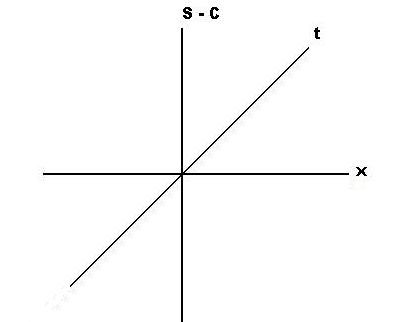 Nevertheless, we now have to consider the existence of at least a fifth dimension in order to account for the spiritual dimension in man (and the universe). [21] (In the diagram, x stands for the three spatial dimensions x, y, z; t for time; and S-C for spirituality or consciousness.) This dimension, though accessible to man’s consciousness, is not reducible to the four dimensions of space-time, and phenomena occurring within it are not necessarily measurable in physical terms. Man, then, is a five-dimensional creature, not four. He is an amphibious being that inhabits two worlds: the physical world with his body, and the spiritual world with his soul. A bird needs two wings in order to be able to fly. Remove one wing, and it cannot. Remove one of man’s two worlds, and he will become a cripple, a stunted creature, no matter how proficient or successful he may be in the other.
Nevertheless, we now have to consider the existence of at least a fifth dimension in order to account for the spiritual dimension in man (and the universe). [21] (In the diagram, x stands for the three spatial dimensions x, y, z; t for time; and S-C for spirituality or consciousness.) This dimension, though accessible to man’s consciousness, is not reducible to the four dimensions of space-time, and phenomena occurring within it are not necessarily measurable in physical terms. Man, then, is a five-dimensional creature, not four. He is an amphibious being that inhabits two worlds: the physical world with his body, and the spiritual world with his soul. A bird needs two wings in order to be able to fly. Remove one wing, and it cannot. Remove one of man’s two worlds, and he will become a cripple, a stunted creature, no matter how proficient or successful he may be in the other.
Higher dimensions have become a stock-in-trade of modern physics. For instance, quantum physics uses a mathematical space of 3n dimensions in order to describe the behavior of an ensemble of n particles. In high-energy physics, string theory has used 11 dimensions with interesting results. Infinite-dimensional phase spaces and Hilbert spaces are not uncommon. The ordinary world we inhabit, however, has hitherto been successfully described by the three spatial dimensions, plus—ever since Einstein—the fourth dimension of time.
 Nevertheless, we now have to consider the existence of at least a fifth dimension in order to account for the spiritual dimension in man (and the universe). [21] (In the diagram, x stands for the three spatial dimensions x, y, z; t for time; and S-C for spirituality or consciousness.) This dimension, though accessible to man’s consciousness, is not reducible to the four dimensions of space-time, and phenomena occurring within it are not necessarily measurable in physical terms. Man, then, is a five-dimensional creature, not four. He is an amphibious being that inhabits two worlds: the physical world with his body, and the spiritual world with his soul. A bird needs two wings in order to be able to fly. Remove one wing, and it cannot. Remove one of man’s two worlds, and he will become a cripple, a stunted creature, no matter how proficient or successful he may be in the other.
Nevertheless, we now have to consider the existence of at least a fifth dimension in order to account for the spiritual dimension in man (and the universe). [21] (In the diagram, x stands for the three spatial dimensions x, y, z; t for time; and S-C for spirituality or consciousness.) This dimension, though accessible to man’s consciousness, is not reducible to the four dimensions of space-time, and phenomena occurring within it are not necessarily measurable in physical terms. Man, then, is a five-dimensional creature, not four. He is an amphibious being that inhabits two worlds: the physical world with his body, and the spiritual world with his soul. A bird needs two wings in order to be able to fly. Remove one wing, and it cannot. Remove one of man’s two worlds, and he will become a cripple, a stunted creature, no matter how proficient or successful he may be in the other.
The Laser

We shall soon return to the subject of the fifth dimension. Before we move on, however, we must consider the second part of the Pilgrimage. We have already mentioned the circumambulations. What metaphor, what simile, does science suggest regarding the Labor between the Twin Hills?
Another extraordinary discovery of modern science and technology has been the laser. This involves, not elementary particles of matter as in the case of the accelerator, but particles of energy—electromagnetic photons, or light.
Ordinary light consists of photons of differing wavelengths, directionality, and phase. The comparison was early made that this corresponds to a choir where everybody is singing a different tune, at a different time, and with a different pitch of voice—a cacophony, in fact. The object of the laser is to ensure, as it were, that all the members of the choir sing the same tune at the same time, and with the same pitch.
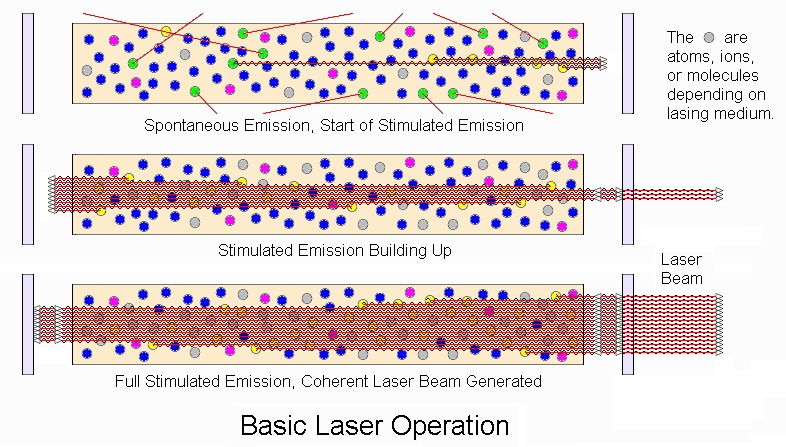 The “lasing medium” has two mirrors at both ends, one semitransparent. Light enters this medium and moves back and forth (at the speed of light, naturally) between these two mirrors, exciting the atoms or molecules of the lasing medium. Light of a different directionality escapes through the walls of the cylinder. This back-and-forth movement continues until the atoms discharge exactly in lockstep, producing a light ray of great “purity” in which all the photons are exactly in phase and monochromatic (of the same color or frequency). When a sufficiently energetic beam is built up, it escapes through the semitransparent mirror, yielding a pencil of “coherent” light—with the same directionality, frequency, and phase.
The “lasing medium” has two mirrors at both ends, one semitransparent. Light enters this medium and moves back and forth (at the speed of light, naturally) between these two mirrors, exciting the atoms or molecules of the lasing medium. Light of a different directionality escapes through the walls of the cylinder. This back-and-forth movement continues until the atoms discharge exactly in lockstep, producing a light ray of great “purity” in which all the photons are exactly in phase and monochromatic (of the same color or frequency). When a sufficiently energetic beam is built up, it escapes through the semitransparent mirror, yielding a pencil of “coherent” light—with the same directionality, frequency, and phase.
Here again, we must be careful to observe that there can be no comparison between a beam of laser light and a human being emerging from the seven trips between the Twin Hills. Yet an analogy does suggest itself, in that perhaps the spiritual energy of the Pilgrim is being further focused, intensified, and rendered coherent during this process—which is the same thing as saying that the Grace of God is somehow being further tempered and improved.
One must be extremely cautious not to overdo such metaphors, or to draw the wrong parallels. The subject must be approached with a gravity commensurate with the occasion. In any case, the simile of the laser, like that of the accelerator, is an interesting one—an allegory [22] that excites the imagination, and suggests that there may be more things in heaven and earth “than are dreamt of in our philosophy.”
Another extraordinary discovery of modern science and technology has been the laser. This involves, not elementary particles of matter as in the case of the accelerator, but particles of energy—electromagnetic photons, or light.
Ordinary light consists of photons of differing wavelengths, directionality, and phase. The comparison was early made that this corresponds to a choir where everybody is singing a different tune, at a different time, and with a different pitch of voice—a cacophony, in fact. The object of the laser is to ensure, as it were, that all the members of the choir sing the same tune at the same time, and with the same pitch.
 The “lasing medium” has two mirrors at both ends, one semitransparent. Light enters this medium and moves back and forth (at the speed of light, naturally) between these two mirrors, exciting the atoms or molecules of the lasing medium. Light of a different directionality escapes through the walls of the cylinder. This back-and-forth movement continues until the atoms discharge exactly in lockstep, producing a light ray of great “purity” in which all the photons are exactly in phase and monochromatic (of the same color or frequency). When a sufficiently energetic beam is built up, it escapes through the semitransparent mirror, yielding a pencil of “coherent” light—with the same directionality, frequency, and phase.
The “lasing medium” has two mirrors at both ends, one semitransparent. Light enters this medium and moves back and forth (at the speed of light, naturally) between these two mirrors, exciting the atoms or molecules of the lasing medium. Light of a different directionality escapes through the walls of the cylinder. This back-and-forth movement continues until the atoms discharge exactly in lockstep, producing a light ray of great “purity” in which all the photons are exactly in phase and monochromatic (of the same color or frequency). When a sufficiently energetic beam is built up, it escapes through the semitransparent mirror, yielding a pencil of “coherent” light—with the same directionality, frequency, and phase. Here again, we must be careful to observe that there can be no comparison between a beam of laser light and a human being emerging from the seven trips between the Twin Hills. Yet an analogy does suggest itself, in that perhaps the spiritual energy of the Pilgrim is being further focused, intensified, and rendered coherent during this process—which is the same thing as saying that the Grace of God is somehow being further tempered and improved.
One must be extremely cautious not to overdo such metaphors, or to draw the wrong parallels. The subject must be approached with a gravity commensurate with the occasion. In any case, the simile of the laser, like that of the accelerator, is an interesting one—an allegory [22] that excites the imagination, and suggests that there may be more things in heaven and earth “than are dreamt of in our philosophy.”
Re-enactment, Participation, Regeneration
The story does not end there, however. As Mircea Eliade has convincingly argued, [23] religious ceremonies are an attempt to re-create the original situation considered to be sacred, and the sacred he has shown to mean the real—or at least, the more real. Everything we experience in our profane, four-dimensional space-time is finite, evanescent, fleeting, temporary. The sacred, on the other hand, is permanent, eternal, ever-present and everlasting. Sacred time is eternally present; it is the eternal now or—to use Alan Watts’ coinage—”nowever,” as indeed sacred space is the eternal here or “here-ever.” Our ordinary space-time is in some way a subset of this sacred space-time—a surface of lesser dimension, as it were, in a space of higher dimension. This space is coextensive with, but not limited or bounded by, our own continuum, and its structure is such that it can be, but is not usually, accessed from every point in our world. [24]
Hence, when a religious person performs a ceremony, he is attempting to draw closer to the primordial event that occurred either solely in sacred space-time, or in its intersection with ours. This means that the “surface” of our continuum is not a smooth plane; it is an undulating surface of both crests and troughs, peaks and valleys. This is the reason why the Kaaba is considered to be “the highest place on earth,” in spite of the fact that the mountains surrounding it are there for all to see. This clearly indicates that the “height” in question is not the physical height of the third dimension.
The story does not end there, however. As Mircea Eliade has convincingly argued, [23] religious ceremonies are an attempt to re-create the original situation considered to be sacred, and the sacred he has shown to mean the real—or at least, the more real. Everything we experience in our profane, four-dimensional space-time is finite, evanescent, fleeting, temporary. The sacred, on the other hand, is permanent, eternal, ever-present and everlasting. Sacred time is eternally present; it is the eternal now or—to use Alan Watts’ coinage—”nowever,” as indeed sacred space is the eternal here or “here-ever.” Our ordinary space-time is in some way a subset of this sacred space-time—a surface of lesser dimension, as it were, in a space of higher dimension. This space is coextensive with, but not limited or bounded by, our own continuum, and its structure is such that it can be, but is not usually, accessed from every point in our world. [24]
Hence, when a religious person performs a ceremony, he is attempting to draw closer to the primordial event that occurred either solely in sacred space-time, or in its intersection with ours. This means that the “surface” of our continuum is not a smooth plane; it is an undulating surface of both crests and troughs, peaks and valleys. This is the reason why the Kaaba is considered to be “the highest place on earth,” in spite of the fact that the mountains surrounding it are there for all to see. This clearly indicates that the “height” in question is not the physical height of the third dimension.
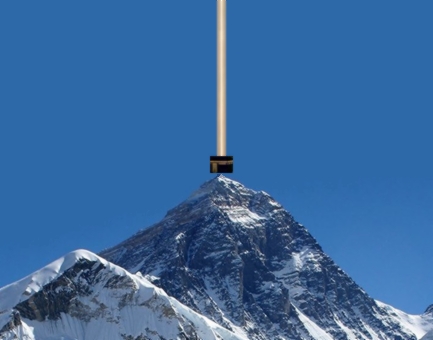
The Kaaba as it may be conceived of in spiritual space.
What all this means is this: the events experienced by Abraham, Hagar, and Ishmael happened in both ordinary space-time and in sacred space-time. They happened on a “mountaintop,” as it were, and precipitated the descent of Divine Grace. Hence, when a pilgrim implements the procedure of the Pilgrimage, he is also attempting to draw closer to that point in space-time by means of this implementation, in order to share in the “rain” of Grace. (Ideally, though impossibly, this wouldabolish the interval separating the here-now from the there-then.) This follows a three-stage process: Re-enactment, participation, and regeneration.
By re-enacting the details of the original ordeals, the pilgrims place themselves in the condition of, the same state-space as, Abraham and his family. They are thus led to participate in the very actions they are emulating by reason of this emulation. (Induction may be an appropriate physical simile for this.) Finally, they harvest the same auspicious results as their archetypal role-models did, since God has here opened an avenue—a channel—to the reception of His Grace. This isregeneration or sanctification, involving a death to the old self and rebirth of a new, pure self, due to which the pilgrim has been promised that “all his earlier sins will be cleansed (forgiven), and he will be as if newborn,” like a Star-Child.
By re-enacting the details of the original ordeals, the pilgrims place themselves in the condition of, the same state-space as, Abraham and his family. They are thus led to participate in the very actions they are emulating by reason of this emulation. (Induction may be an appropriate physical simile for this.) Finally, they harvest the same auspicious results as their archetypal role-models did, since God has here opened an avenue—a channel—to the reception of His Grace. This isregeneration or sanctification, involving a death to the old self and rebirth of a new, pure self, due to which the pilgrim has been promised that “all his earlier sins will be cleansed (forgiven), and he will be as if newborn,” like a Star-Child.
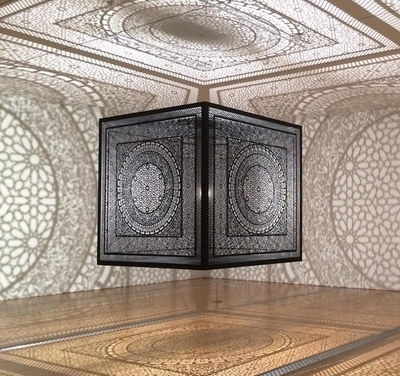
Anila Q. Agha: Intersections, ArtPrize 2014. The cube is lit from within. The intricately laser-cut patterns
cast shadows on the walls and ceiling, evoking the sacred space of the Alhambra Palace.
cast shadows on the walls and ceiling, evoking the sacred space of the Alhambra Palace.
The Black Stone
Of the complex of symbols and processes surrounding the Pilgrimage, one remains to be dealt with: the Black Stone—the heart, as it were, of the Black Cube that comprises the Kaaba.
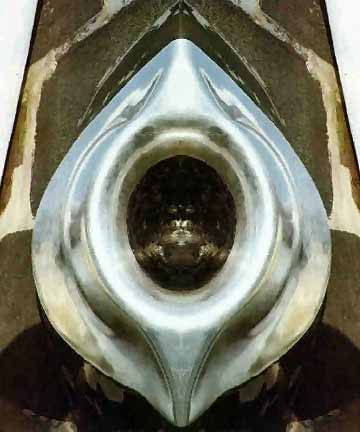 All pilgrimages are, to borrow a phrase from Jules Verne, a “Journey to the Center of the World.” (“World” here does not, of course, mean the physical globe of the earth.) In a certain very real sense, the pilgrim is returning to the Origin, both in space and in time, of the universe. The North Pole—pointing toward the North Star—is a fitting image for this “still point of the turning world.” Since Adam, the first man, was the first to visit the Black Stone and circumambulate it, this event is an archetypal model for all subsequent journeys by all human beings to all other sanctuaries conceived of as being “the Center of the World,” [25] for which, in turn, the Black Stone constitutes the archetype. This is not all, however. The Kaaba also “faces the center of Heaven” [26], which means that a vertical axis connects the Center of the World with the Center of Heaven. This can be represented if we lump the three spatial dimensions x, y, z into one axis and show the dimension of time t on a second axis, thus reducing space-time to a plane. (This is, in fact, nothing other than adding a third axis to a space-time diagram—as we just saw above.) Again, it should be stressed that this vertical dimension is not the third physical dimension of height.
All pilgrimages are, to borrow a phrase from Jules Verne, a “Journey to the Center of the World.” (“World” here does not, of course, mean the physical globe of the earth.) In a certain very real sense, the pilgrim is returning to the Origin, both in space and in time, of the universe. The North Pole—pointing toward the North Star—is a fitting image for this “still point of the turning world.” Since Adam, the first man, was the first to visit the Black Stone and circumambulate it, this event is an archetypal model for all subsequent journeys by all human beings to all other sanctuaries conceived of as being “the Center of the World,” [25] for which, in turn, the Black Stone constitutes the archetype. This is not all, however. The Kaaba also “faces the center of Heaven” [26], which means that a vertical axis connects the Center of the World with the Center of Heaven. This can be represented if we lump the three spatial dimensions x, y, z into one axis and show the dimension of time t on a second axis, thus reducing space-time to a plane. (This is, in fact, nothing other than adding a third axis to a space-time diagram—as we just saw above.) Again, it should be stressed that this vertical dimension is not the third physical dimension of height.
This axis, then, is in fact the path of “descent” or projection of the Black Stone from its heavenly counterpart onto the earth. It is also the invisible axis around which the counterclockwise circuits occur, and toward which Moslems in concentric circles prostrate themselves in Formal Prayer all over the world. (We have already mentioned the force field occurring perpendicular to the plane of circular motion, which if existent would coincide with this axis.)
The Black Stone is the foundation stone of the Kaaba, in the sense that it was originally at its center and was the first stone to be “laid.” Later, however, it was moved from the center to the corner for easy access (since the House of God is seldom entered), and during the reconstruction of the Kaaba at various times it was the cornerstone, the last stone to be lifted into place. And “the cornerstone is at the exact center of the world.” [27]
 The Black Stone, then, is the keystone in the sense that it is both the first and the last, the alpha and the omega. At first, its displacement from the center of the Kaaba (the vertical axis) to the corner may appear to be a discrepancy. The alif, however—the first letter of the Arabic alphabet, as is aleph in the Hebrew—consists of a vertical stroke slightly curved to one side at the bottom.
The Black Stone, then, is the keystone in the sense that it is both the first and the last, the alpha and the omega. At first, its displacement from the center of the Kaaba (the vertical axis) to the corner may appear to be a discrepancy. The alif, however—the first letter of the Arabic alphabet, as is aleph in the Hebrew—consists of a vertical stroke slightly curved to one side at the bottom.
Now the significance of this alif is threefold. First, it is the first letter of the Supreme Name of God (Allah), and hence represents that Divine Name. Second, it highly resembles the numeral “1”, and reminds us that God is One. And finally, it represents the vertical axis, the axial pillar. Its upper point represents the Secret of Secrets, reaching all the way up to the Archetypal Stone in Heaven and passing, perhaps, even beyond, to the Paradise of the Essence. And on the other hand, its lower end corresponds exactly to the position of the Keystone, the Black Stone of the Kaaba. [28]
Now we have already associated the seven circumambulations with an increase in spiritual/psychic energy, and the seven trips with a refinement, a coherence, of this energy. One question, however, remains: energy for what?
Of the complex of symbols and processes surrounding the Pilgrimage, one remains to be dealt with: the Black Stone—the heart, as it were, of the Black Cube that comprises the Kaaba.
 All pilgrimages are, to borrow a phrase from Jules Verne, a “Journey to the Center of the World.” (“World” here does not, of course, mean the physical globe of the earth.) In a certain very real sense, the pilgrim is returning to the Origin, both in space and in time, of the universe. The North Pole—pointing toward the North Star—is a fitting image for this “still point of the turning world.” Since Adam, the first man, was the first to visit the Black Stone and circumambulate it, this event is an archetypal model for all subsequent journeys by all human beings to all other sanctuaries conceived of as being “the Center of the World,” [25] for which, in turn, the Black Stone constitutes the archetype. This is not all, however. The Kaaba also “faces the center of Heaven” [26], which means that a vertical axis connects the Center of the World with the Center of Heaven. This can be represented if we lump the three spatial dimensions x, y, z into one axis and show the dimension of time t on a second axis, thus reducing space-time to a plane. (This is, in fact, nothing other than adding a third axis to a space-time diagram—as we just saw above.) Again, it should be stressed that this vertical dimension is not the third physical dimension of height.
All pilgrimages are, to borrow a phrase from Jules Verne, a “Journey to the Center of the World.” (“World” here does not, of course, mean the physical globe of the earth.) In a certain very real sense, the pilgrim is returning to the Origin, both in space and in time, of the universe. The North Pole—pointing toward the North Star—is a fitting image for this “still point of the turning world.” Since Adam, the first man, was the first to visit the Black Stone and circumambulate it, this event is an archetypal model for all subsequent journeys by all human beings to all other sanctuaries conceived of as being “the Center of the World,” [25] for which, in turn, the Black Stone constitutes the archetype. This is not all, however. The Kaaba also “faces the center of Heaven” [26], which means that a vertical axis connects the Center of the World with the Center of Heaven. This can be represented if we lump the three spatial dimensions x, y, z into one axis and show the dimension of time t on a second axis, thus reducing space-time to a plane. (This is, in fact, nothing other than adding a third axis to a space-time diagram—as we just saw above.) Again, it should be stressed that this vertical dimension is not the third physical dimension of height. This axis, then, is in fact the path of “descent” or projection of the Black Stone from its heavenly counterpart onto the earth. It is also the invisible axis around which the counterclockwise circuits occur, and toward which Moslems in concentric circles prostrate themselves in Formal Prayer all over the world. (We have already mentioned the force field occurring perpendicular to the plane of circular motion, which if existent would coincide with this axis.)
The Black Stone is the foundation stone of the Kaaba, in the sense that it was originally at its center and was the first stone to be “laid.” Later, however, it was moved from the center to the corner for easy access (since the House of God is seldom entered), and during the reconstruction of the Kaaba at various times it was the cornerstone, the last stone to be lifted into place. And “the cornerstone is at the exact center of the world.” [27]
 The Black Stone, then, is the keystone in the sense that it is both the first and the last, the alpha and the omega. At first, its displacement from the center of the Kaaba (the vertical axis) to the corner may appear to be a discrepancy. The alif, however—the first letter of the Arabic alphabet, as is aleph in the Hebrew—consists of a vertical stroke slightly curved to one side at the bottom.
The Black Stone, then, is the keystone in the sense that it is both the first and the last, the alpha and the omega. At first, its displacement from the center of the Kaaba (the vertical axis) to the corner may appear to be a discrepancy. The alif, however—the first letter of the Arabic alphabet, as is aleph in the Hebrew—consists of a vertical stroke slightly curved to one side at the bottom. Now the significance of this alif is threefold. First, it is the first letter of the Supreme Name of God (Allah), and hence represents that Divine Name. Second, it highly resembles the numeral “1”, and reminds us that God is One. And finally, it represents the vertical axis, the axial pillar. Its upper point represents the Secret of Secrets, reaching all the way up to the Archetypal Stone in Heaven and passing, perhaps, even beyond, to the Paradise of the Essence. And on the other hand, its lower end corresponds exactly to the position of the Keystone, the Black Stone of the Kaaba. [28]
Now we have already associated the seven circumambulations with an increase in spiritual/psychic energy, and the seven trips with a refinement, a coherence, of this energy. One question, however, remains: energy for what?
3001
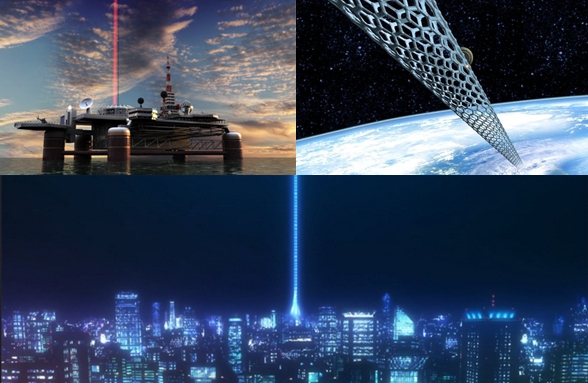
Almost thirty years after 2001, Arthur C. Clarke published 3001: The Final Odyssey. [29] His plot was as imaginative as ever. Astronaut Poole dies, is resurrected a thousand years in the future, goes to Star City (the “Heavenly City”—remember New Jerusalem and Wells’ Time Traveler), up to which leads, from the earth, the “Space Elevator.” There are four of these elevators contained in towers reaching up to “the Heavenly City,” which girdles the earth like a ring (refer back to the symbolism of the ring and the circle). This Tower is a “gigantic, sky-piercing cylinder” which, as Clarke tells us in his “Sources,” until recently could only be made of diamond. But this is precisely Plato’s “axis of diamond” which he describes as the World Axis, another description for which is the “pillar of light.” [30] (Since the book was published, there have been concrete proposals to build real-life space elevators using ultrastrong materials.)
Now the primeval Pen (the Qalam, mentioned in 68:1) is light in Islam. According to a Tradition, the Pen, of which the pencil-like minarets of a mosque are symbolic, was the First Light and the First Spirit to be created. [31] Likewise, the writing by the Pen on the Guarded Tablet is a light of God.
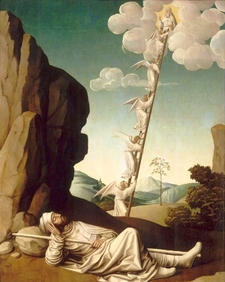 At this point we might remember that there was another House of God besides the Kaaba, for which, as we have seen, the latter provides the archetype. Jacob, in his dream at Haran, saw a ladder reaching up to heaven, with angels ascending and descending on it, and heard the Lord speaking from above it, saying: “I am the Lord God of Abraham.” Jacob woke up, and said: “This is none other but the house of God, and this is the Gate of Heaven” (named the “Sun Door” in other traditions—recall the “Star Gate” of 2001). He took a stone that had been serving as his pillow, set it up as a monument, and called the place Beth-El: “the House of God” (Genesis,28:12-19).
At this point we might remember that there was another House of God besides the Kaaba, for which, as we have seen, the latter provides the archetype. Jacob, in his dream at Haran, saw a ladder reaching up to heaven, with angels ascending and descending on it, and heard the Lord speaking from above it, saying: “I am the Lord God of Abraham.” Jacob woke up, and said: “This is none other but the house of God, and this is the Gate of Heaven” (named the “Sun Door” in other traditions—recall the “Star Gate” of 2001). He took a stone that had been serving as his pillow, set it up as a monument, and called the place Beth-El: “the House of God” (Genesis,28:12-19). Moreover, Eliade has collated evidence from all over the world that this cosmic pillar, or “Jacob’s Ladder,” has been known to all people of all cultures and all places. Here are some of the names it has been called: Pillar of the Universe (which supports heaven and all things). World Axis. Universal Column. Sacred Pillar. Door to the World Above. Cosmic Pole. Pole of Heaven. Center of the World (located “in the Middle,” at the “Navel of the Earth”). Post of the World. Universal Pillar. Jedi Column. Link between Heaven and Earth. As Eliade is careful to note: “The multiplicity, or even the infinity, of centers of the world raises no difficulty for religious thought. For it is not a matter of geometrical space, but of an existential and sacred space that has an entirely different structure, that admits of an infinite number of breaks and hence is capable of an infinite number of communications with the transcendent.” [32]
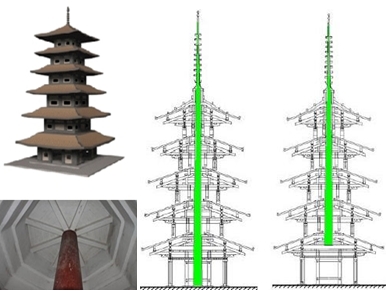 Furthermore, this Cosmic Pillar forms the axis of the Cosmic Mountain (the Magic Mountain that represents the universe), the Sacred Mountain (e.g. Mt. Meru, Mt. Alburz, Mt. Gerizim, Mt. Olympus), the cone that represents this mountain, the evergreen Christmas tree with a star at the top which resembles the mountain, the Wheel of Life, the World Tree, the Tree of Life, of which—for example—the shinbashira (“heart pillar”) column at the center of Japanese pagodas is symbolic. In the upward direction are ordered the various heavens. Its base is in our four-dimensional space-time continuum. In the negative direction, towards the underground roots, are the various hells and infernal regions.
Furthermore, this Cosmic Pillar forms the axis of the Cosmic Mountain (the Magic Mountain that represents the universe), the Sacred Mountain (e.g. Mt. Meru, Mt. Alburz, Mt. Gerizim, Mt. Olympus), the cone that represents this mountain, the evergreen Christmas tree with a star at the top which resembles the mountain, the Wheel of Life, the World Tree, the Tree of Life, of which—for example—the shinbashira (“heart pillar”) column at the center of Japanese pagodas is symbolic. In the upward direction are ordered the various heavens. Its base is in our four-dimensional space-time continuum. In the negative direction, towards the underground roots, are the various hells and infernal regions. Now, the laser would probably be the best simile for this world axis. Two facts, however, militate against it. First, the laser is monochromatic (of a single frequency or color), whereas the pillar is always composed of white light, which is a composite of all colors. Second, the axis is curved at the bottom, which never occurs with a laser. So, as our final symbol or metaphor from modern science and technology, we shall choose: the fusion reactor.
The Tokamak
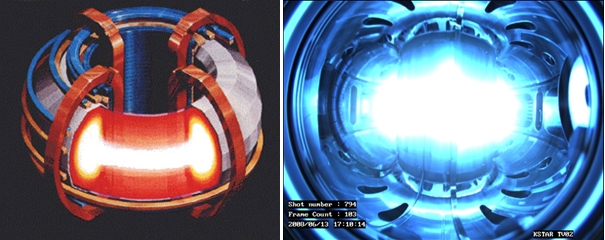
Left: The tokamak fusion reactor design seeks to confine plasma using powerful magnetic fields. Right: The experimental Korean tokamak KSTAR achieved plasma state in 2008. In 2012, it confined plasma for 17 seconds@50 million degrees Celsius.
Two schemes have been proposed for achieving thermonuclear fusion: inertial confinement and magnetic confinement. Of these strategies, we select magnetic confinement as our model, and more specifically the tokamak design, first proposed by Igor Tamm and Andrei Sakharov.
The four classical elements of earth, water, air, and fire have today found their counterparts in the four states of matter recognized by modern physics: solid, liquid, gas, and plasma. When matter is heated to temperatures that exist within the sun’s core—say, a hundred million degrees—the ordinary structure of the atom can no longer be maintained, and a fourth, “plasma,” state is reached where electrons and nuclei exist freely without bonding to each other. The nuclei, thus stripped of their electrons, are able to “fuse,” liberating immense amounts of energy.
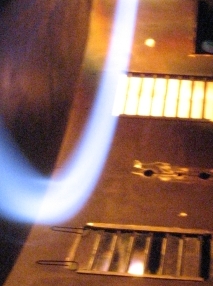 This plasma would, of course, instantly vaporize anything it came into contact with, so the idea has been proposed of confining it in a “magnetic bottle.” In the tokamak design, this bottle consists of a toroid, or doughnut-shaped ring. Although tokamaks of the same circumference as the LHC have not yet been built, one can imagine such a device, a short segment of which—while still curved—would then approximate a straight line.
This plasma would, of course, instantly vaporize anything it came into contact with, so the idea has been proposed of confining it in a “magnetic bottle.” In the tokamak design, this bottle consists of a toroid, or doughnut-shaped ring. Although tokamaks of the same circumference as the LHC have not yet been built, one can imagine such a device, a short segment of which—while still curved—would then approximate a straight line.
In this device, a shaft of white-hot plasma is separated from all external things by means of an insulating wall, and is confined by magnetic field lines that prevent the plasma from touching the wall. Here, too, would be a sign for those who wish to consider such “signs on the horizons and in themselves.”
The four classical elements of earth, water, air, and fire have today found their counterparts in the four states of matter recognized by modern physics: solid, liquid, gas, and plasma. When matter is heated to temperatures that exist within the sun’s core—say, a hundred million degrees—the ordinary structure of the atom can no longer be maintained, and a fourth, “plasma,” state is reached where electrons and nuclei exist freely without bonding to each other. The nuclei, thus stripped of their electrons, are able to “fuse,” liberating immense amounts of energy.
 This plasma would, of course, instantly vaporize anything it came into contact with, so the idea has been proposed of confining it in a “magnetic bottle.” In the tokamak design, this bottle consists of a toroid, or doughnut-shaped ring. Although tokamaks of the same circumference as the LHC have not yet been built, one can imagine such a device, a short segment of which—while still curved—would then approximate a straight line.
This plasma would, of course, instantly vaporize anything it came into contact with, so the idea has been proposed of confining it in a “magnetic bottle.” In the tokamak design, this bottle consists of a toroid, or doughnut-shaped ring. Although tokamaks of the same circumference as the LHC have not yet been built, one can imagine such a device, a short segment of which—while still curved—would then approximate a straight line. In this device, a shaft of white-hot plasma is separated from all external things by means of an insulating wall, and is confined by magnetic field lines that prevent the plasma from touching the wall. Here, too, would be a sign for those who wish to consider such “signs on the horizons and in themselves.”
The Inner Space Elevator
Most important of all, the cosmic pillar is the axis along which the Ascension to Heaven occurs. We hasten to add that this Ascension, also known to all peoples, does not refer to a physical elevation into outer space, but again to a spiritual elevation in inner space. This Ascension to Heaven and to God is called miraj in Arabic. The latter word should not be confused with “mirage,” meaning an optical illusion and deriving from the Latin mirari (to wonder at) as well as the French mirer (to look at, to aim at). On the contrary, miraj means “ladder” or “stairway,” and in our day would mean “elevator” or “escalator.” Its plural, maarij, is the name of a chapter in the Koran and is mentioned in the same chapter (70:3-4). This implies that there are more than two “stairways”—in fact, a plurality of Ascensions, the greatest and most famous of which is Mohammed’s Ascension.
Most important of all, the cosmic pillar is the axis along which the Ascension to Heaven occurs. We hasten to add that this Ascension, also known to all peoples, does not refer to a physical elevation into outer space, but again to a spiritual elevation in inner space. This Ascension to Heaven and to God is called miraj in Arabic. The latter word should not be confused with “mirage,” meaning an optical illusion and deriving from the Latin mirari (to wonder at) as well as the French mirer (to look at, to aim at). On the contrary, miraj means “ladder” or “stairway,” and in our day would mean “elevator” or “escalator.” Its plural, maarij, is the name of a chapter in the Koran and is mentioned in the same chapter (70:3-4). This implies that there are more than two “stairways”—in fact, a plurality of Ascensions, the greatest and most famous of which is Mohammed’s Ascension.
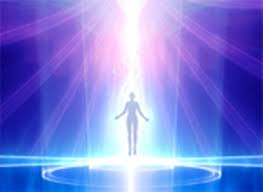
Thus, Clarke’s “Space Elevator” in psychic reality corresponds to the Inner Space Elevator, called miraj in Islam. And this elevator itself is symbolic of the Ascending [33] Straight Path of Islam, which, when carried out faithfully, constitutes the foolproof algorithm for sanctity and happiness. We thus begin to see how right Moslems have been in claiming that Islam is the perennial religion, the archetypal religion that combines and incorporates all religions, philosophies, and mysticism.
Conclusion
We see, therefore, that the spiritual/psychic energy granted by God during the Pilgrimage will help pilgrims, in the future life, to ascend to a level in accordance with their accomplishments. This is one of the greatest boons of God that can be bestowed on a human being—any human being.
A good analogy for this process by which people are “beamed up” might be the model of the atom provided by modern physics. The atom pictured as a miniature solar system came to Niels Bohr (like Kekulé’s benzene ring, and the DNA double helix) in a dream. Although this view has long since been superseded, a part of Bohr’s model is still with us, in which the electrons orbiting an atomic nucleus are conceived of as inhabiting different energy levels. Each “shell” surrounding the nucleus corresponds to a different step on the “energy staircase.” An electron absorbing a quantum of energy (a photon) jumps to a higher energy level, and any electron receiving enough energy to be knocked out of the upmost level becomes “liberated” to wander as a free electron. In the present analogy, the steps of the energy staircase would correspond to the various levels of heavens, and the liberated electrons would correspond to the saints (or “friends of God,” or “the Free”) who are drawn near to the Divine Presence. (Proximity to God is preferable to any heavenly state, no matter how wonderful.)
But the Pilgrimage is a journey which, after all, only a comparatively few can embark on. What about all the rest who cannot make the trip in their lifetimes?
Fortunately, the Pilgrimage is not the only way that one can attain to Ascension. For the Prophet of God returned from his Ascension with the great good news that human beings can purify themselves and come closer to God by another method,which he enjoined on all Moslems: namely, the Formal Prayer. “The (Formal) Prayer,” he said, “is the Ascension of the Faithful.” And, further: “Who has no (Formal) Prayer has no Ascension.” This means that God has folded up the possibility of Ascension and placed it in the Formal Prayer.
All this, and much more besides, is dealt with in the Koran, which incorporates and goes beyond (represents the culmination of) the previous three books (the Bible), and which constitutes God’s Final Testament to mankind.
We see, therefore, that the spiritual/psychic energy granted by God during the Pilgrimage will help pilgrims, in the future life, to ascend to a level in accordance with their accomplishments. This is one of the greatest boons of God that can be bestowed on a human being—any human being.
A good analogy for this process by which people are “beamed up” might be the model of the atom provided by modern physics. The atom pictured as a miniature solar system came to Niels Bohr (like Kekulé’s benzene ring, and the DNA double helix) in a dream. Although this view has long since been superseded, a part of Bohr’s model is still with us, in which the electrons orbiting an atomic nucleus are conceived of as inhabiting different energy levels. Each “shell” surrounding the nucleus corresponds to a different step on the “energy staircase.” An electron absorbing a quantum of energy (a photon) jumps to a higher energy level, and any electron receiving enough energy to be knocked out of the upmost level becomes “liberated” to wander as a free electron. In the present analogy, the steps of the energy staircase would correspond to the various levels of heavens, and the liberated electrons would correspond to the saints (or “friends of God,” or “the Free”) who are drawn near to the Divine Presence. (Proximity to God is preferable to any heavenly state, no matter how wonderful.)
But the Pilgrimage is a journey which, after all, only a comparatively few can embark on. What about all the rest who cannot make the trip in their lifetimes?
Fortunately, the Pilgrimage is not the only way that one can attain to Ascension. For the Prophet of God returned from his Ascension with the great good news that human beings can purify themselves and come closer to God by another method,which he enjoined on all Moslems: namely, the Formal Prayer. “The (Formal) Prayer,” he said, “is the Ascension of the Faithful.” And, further: “Who has no (Formal) Prayer has no Ascension.” This means that God has folded up the possibility of Ascension and placed it in the Formal Prayer.
All this, and much more besides, is dealt with in the Koran, which incorporates and goes beyond (represents the culmination of) the previous three books (the Bible), and which constitutes God’s Final Testament to mankind.
[15] Fritjof Schuon, Understanding Islam (London: Allen & Unwin, 1976) [1963], p. 79.
[16] Titus Burckhardt, Alchemy (Baltimore, MD: Penguin, 1972) [1960], p. 85, 126.
[17] In connection with the esoteric aspect of the journey, it is also said that the three pillars stand for satanic manifestations that prevent the Unification of Actions, of Attributes, and of the Essence. Or, again, satanic manifestations at the level of Sacred Law, of Spiritual Schools, and of Gnostic Knowledge (the culmination of which is the attainment of Reality).
[18] According to Ibn Arabi, 7 represents the Seven Essential Attributes of God: Power, Will, Knowledge, Life, Hearing, Sight and Speech.
[19] Fritz Meier, "The Mystery of the Ka‘ba," in Joseph Campbell (ed.), The Mysteries: Papers from the Eranos Yearbooks (Princeton, NJ: Princeton University Press (Bollingen Series), 1990) [1955], p. 164n41.
[20] Jili, The Perfect Man, quoted in ibid., n42.
[21] See the article on Superheroes on this website.
[22] "Allegory is the interpretation of experience by means of images"—Dorothy Sayers (in her Introduction to the Divine Comedy, quoted by Philip Wayne in the Introduction to his translation of Faust, Part Two ).
[23] Eliade, op. cit.
[24] See the discussion of a fifth dimension in the “Superheroes” article.
[25] Eliade, p. 183.
[26] Quoted in Eliade, p. 38.
[27] Ibid., p. 54. (Italics in the original.)
[28] René Guénon, Fundamental Symbols (Cambridge: Quinta Essentia, 1996) [1962], p. 192n19.
[29] A. C. Clarke, 3001: The Final Odyssey (New York: Ballantine Books, 1997).
[30] Guénon, p. 196.
[31] “First” here corresponding to “Mohammedan.”
[32] Eliade, p. 57.
[33] Sirat al-mustaqim: “The ascending path.” Guénon, p. 156n7.